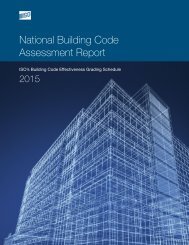CROSS REFERENCE GUIDE ACCESSIBILITY PROVISIONS 2010 CBC to 2013 CBC
2010CBC-2013CBC_CrossReferenceMatrix
2010CBC-2013CBC_CrossReferenceMatrix
Create successful ePaper yourself
Turn your PDF publications into a flip-book with our unique Google optimized e-Paper software.
<strong>2010</strong> <strong>CBC</strong> Chapter 11B <strong>2013</strong> <strong>CBC</strong> Chapter 11B Comments<br />
2. 11B-404.2.9, Item 1 & 2 Technical requirements for doors –<br />
opening force for interior doors<br />
3. 11B-404.2.9,Item 4 Technical requirements for doors –<br />
opening force for exterior doors<br />
Exception 1 11B-404.2.9, Exception 1 Exception for doors <strong>to</strong> machinery spaces<br />
Exception 2 11B-404.2.9, Exception 2,<br />
including items a through e<br />
Exception for banks of doors<br />
1133B.2.5.1 Door closer.<br />
1133B.2.5.2<br />
1133B.2.6 Smooth surface.<br />
1133B.3 Corridors, hallways and<br />
exterior exit balconies.<br />
11B-404.2.8.1 Door Closers<br />
and Gate Closers<br />
• 11B-404.2.7 Door and Gate<br />
Hardware<br />
• 11B-309.4 Operation<br />
11B-404.2.10 Door and Gate<br />
Surfaces<br />
11B-403.5.1, Clear Width<br />
Technical requirements for doors – door<br />
closer speed<br />
Technical requirements for doors – door<br />
hardware<br />
Technical requirements for doors –<br />
surfaces within 10 inches of the floor<br />
General technical requirements for width<br />
of accessible routes<br />
1133B.3.1 Corridor and hallway<br />
widths.<br />
11B-403.5.1, Exception 2 Exception <strong>to</strong> the requirement for a 36”<br />
minimum wide accessible route –<br />
corridors serving an occupant load of 10<br />
or more require a 44” minimum width<br />
1133B.3.2 Corridors and<br />
hallways over 200 feet (60 960<br />
mm).<br />
Exception 1<br />
Exception 2<br />
11B-403.5.3 Passing Spaces<br />
• 11B-202.3 Alterations.<br />
Exception 2. Technically<br />
Infeasible.<br />
• 11B-202.4 Path of Travel<br />
Requirements in Alterations,<br />
Additions and Structural<br />
Repairs. Exception 8.<br />
• 11B-202.3 Alterations.<br />
Exception 2. Technically<br />
Infeasible.<br />
• 11B-202.4 Path of Travel<br />
Requirements in Alterations,<br />
Additions and Structural<br />
Repairs. Exception 8.<br />
Technical requirements for corridors and<br />
hallways over 200 feet – 60” width or<br />
passing spaces<br />
The Unreasonable Hardship exceptions for<br />
specific situations are replaced by<br />
provisions for technical infeasibility and an<br />
unreasonable hardship for path of travel<br />
improvements. These exceptions must be<br />
developed by the applicant on a case-bycase<br />
basis for submission <strong>to</strong> the enforcing<br />
authority for its consideration and, if<br />
approved, documentation <strong>to</strong> its file.<br />
The Unreasonable Hardship exceptions for<br />
specific situations are replaced by<br />
provisions for technical infeasibility and an<br />
unreasonable hardship for path of travel<br />
improvements. These exceptions must be<br />
developed by the applicant on a case-bycase<br />
basis for submission <strong>to</strong> the enforcing<br />
authority for its consideration and, if<br />
approved, documentation <strong>to</strong> its file.<br />
1133B.4 Stairways. 11B-210.1 General Scoping for stairways<br />
Cross Reference Guide - <strong>2010</strong> <strong>CBC</strong> <strong>to</strong> <strong>2013</strong> <strong>CBC</strong> Page 87 of 114<br />
Section 1133B General Accessibility for Entrances, Exits and Paths of Travel July 1, 2015



